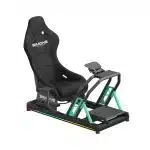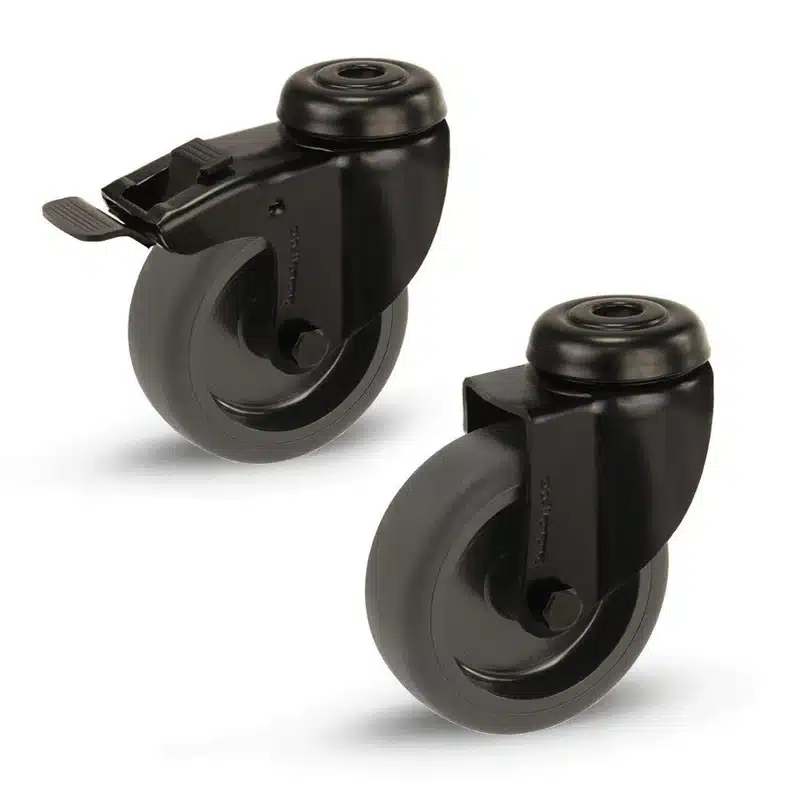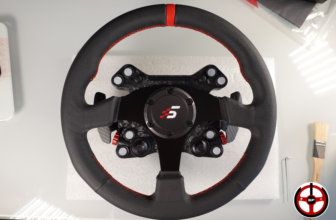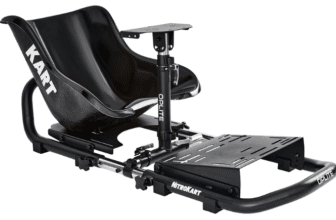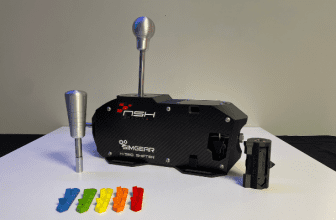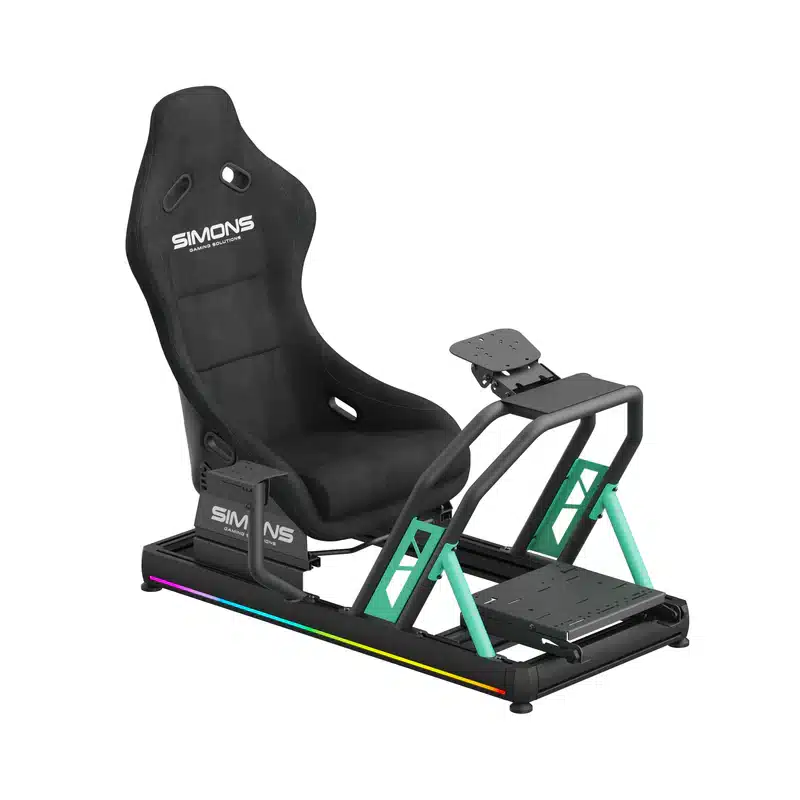
If you’re looking for a sim racing chassis in tubular and aluminum sections that combines robustness and design, the new Simons S1 cockpit may just raise your eyebrows. The creators of the Simplace.co website decided to go into the business of designing and manufacturing simulation equipment, and their chassis takes a chance by combining the best of the two worlds of extrusions and tubulars. Has the gamble paid off? Let’s take a look at what they have to offer and see for ourselves!
What does the Simons S1 Cockpit look like technically?
| Frame construction | Low-profile aluminum structure; Tubular uprights; Steel bottom bracket and Direct Drive base. |
| Seat | Simons S1 Cockpit black fiberglass bucket seat |
| Dimensions | Footprint: 120x60cm Height from floor to top of seat: 110cm |
| Pilot size | Pilots from 1m60 to 1m90. |
| In the boxes | Profile and tubular structure; Bottom bracket and base ; Gearbox support: Black bucket seat; Two LED strips that integrate with the profiles; LED connection box and USB cable; Rubber insulating feet; Cable clips ; Screws and tools; |
| Price | 613.40 excluding VAT or €736.08 including VAT in France (20% VAT) |
Design and ergonomics
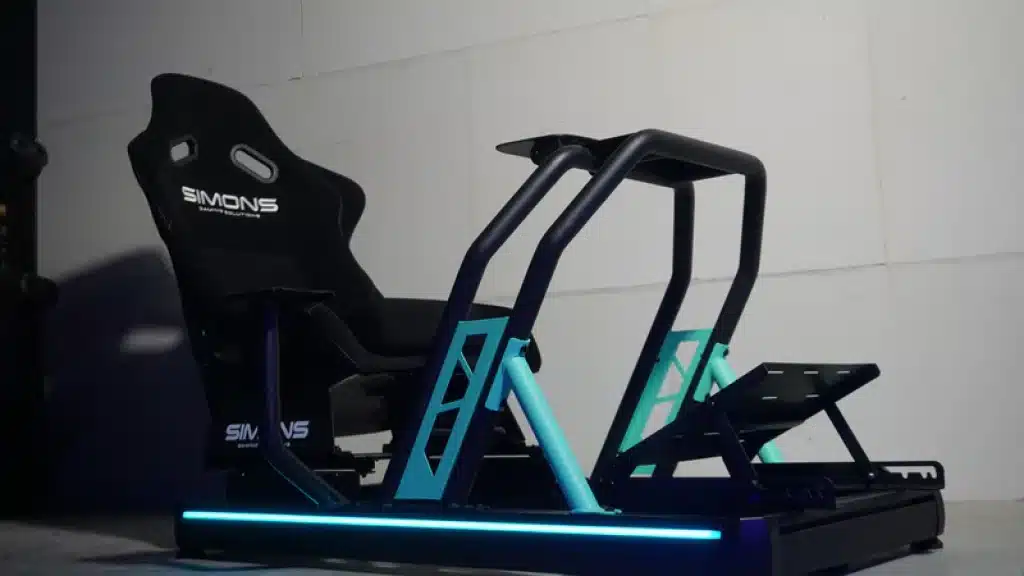
Design-wise, it’s all subjective, but I think the S1 model is a real winner. The black and turquoise anodized powder-coat finish on the tubular upright supports is not only attractive, but also guarantees that the paint will stand the test of time.
The seat is a fiberglass bucket with turquoise-blue stitched cotton upholstery bearing the brand name. The gearbox mount is not sold as an option, but is supplied as part of the original chassis. Last but not least, Simons adds two LED strips. These will serve either to add an atmospheric glow or to react in real time to your engine’s revolutions per minute by reacting to the game’s sound. The whole thing rests on rubber feet that support up to 120Kg of load.
Assembling the Simons S1 Cockpit
Simons claims that the S1 can be assembled in half an hour by a single person. And having looked carefully at the instructions, this is a time target that seems achievable by the average DIYer. The structure is fairly simple, with 4 aluminium sections forming the cockpit support. An additional profile will finish off the base on which the pedal bracket will be fixed. Then come the bucket seat supports and the tubular uprights that will house your base.
Available adjustments
The fact that the seat and chainstay brackets are fixed to the profiles has one advantage: you can adjust your riding position much more widely than on a conventional tubular. All you have to do is move the entire seat or steering wheel support forward or back to adjust your riding position as you see fit. Then juggle with the 22cm of clearance in the seat slides to finalize the position. The same goes for the gearbox support. This too is screwed directly onto the upper face of the left or right-hand profile, depending on whether you like to drive vehicles with the steering wheel on the left or right… So backwards, according to Jeremy Clarkson!

The seat tilt can be adjusted to -6° and its height modulated by 2.5cm. The shifter, which can be positioned on the left or right, can also be tilted by 16°. As for the base tilt, you can tilt it by -25° to suit both straight-shaft bases and those with an angle in the construction.
Last but probably most important: the bottom bracket support plate can also be tilted in stages. On the menu: 0°, 7.5°, 15° and 25°. And it’s worth noting that this adjustment can be made by hand, thanks to two notched knobs.
Compatible equipment
Now that we’ve seen the settings, let’s move on to compatibility with sim racing wheelbases, pedalsets and shifters on the market. The good news is that the Simons S1 Cockpit is equipped with standard holes that fit the vast majority of SimRacing brands. Whether you’re equipped with Fanatec, Asetek, Simagic, Moza, Thrustmaster, Logitech or Simucube gear, you’ll be fine. And given that the majority of other brands generally use the same screw placements as those already mentioned, we can say we’re in the clear.
What about rigidity?
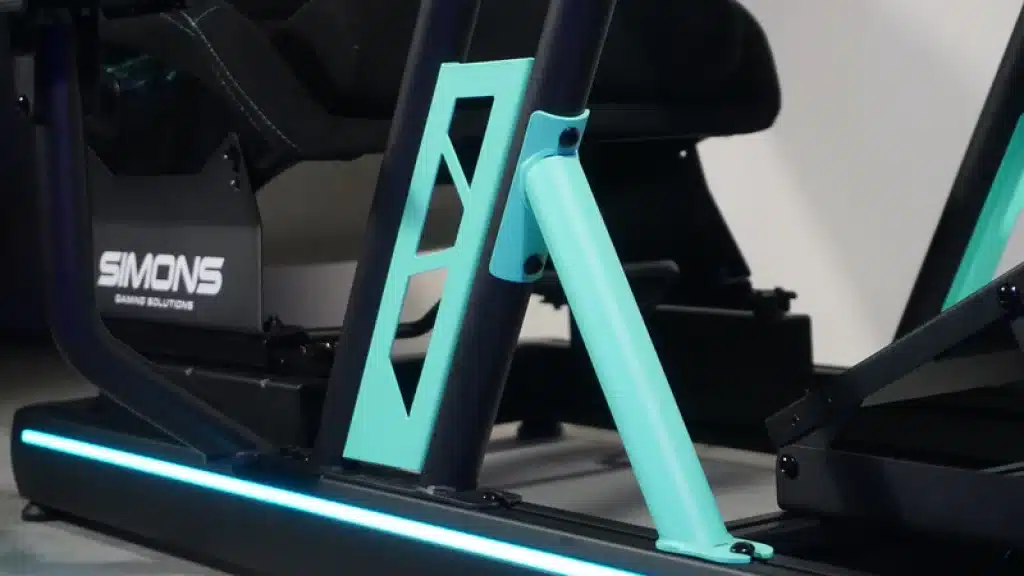
The bottom bracket is made of 3mm-thick metal bent at the ends. This is something that has been improved by the brand since the first version of the chassis, which was then equipped with a flat 2mm bracket. The aim here was to gain massive rigidity without installing a thicker, more expensive plate.
The tubular uprights are screwed directly to the profile and supported by reinforcements (turquoise blue), so I’m not worried about lateral movement. However, we don’t know the thickness of the base support plate. This is a point to be wary of, as it could cause forward/backward bending, but of course it remains to be verified in real-life conditions.
Available accessories and prices
Accessories go hand in hand with chassis! And in the case of the Simons S1, two optional products are currently available.
- Sim Racing USB Hub: a block of USB-A sockets supplied with 12V via a 1-meter-long USB cable, available in 3 versions. 4 USB ports for 53.63€HT, 7 ports for 63.39€HT and 10 ports for 77.04€HT. The Hub is integrated directly into the chassis using T-nuts and holes in the front and rear of the block.
- Castors for moving the chassis: Available in a 4-caster version (which increases the maximum capacity to 160kg), two of which are equipped with brakes, at a price of 63.39€HT. Or in a 6-caster version (max capacity 240Kg), two of which have brakes, at a price of 77.04€HT. In both cases, the height of the castors is 68mm.
Simons Gaming Solutions will also soon be offering screen supports ranging from single to triple screens (with an optional 4th top screen). But these will not be brackets that can be integrated directly into the chassis.
Bonus: free shipping (a pleasure!)
Some good news to add to the mix! Simons Gaming Solutions offers free shipping in many countries. This is the case in France, Belgium, Luxembourg, Italy, the UK, Austria and the Netherlands. A welcome effort when you consider that shipping costs for chassis can sometimes run into three figures!
Our expectations and outstanding questions about the Simons S1 Cockpit
As always with a chassis, my number-one expectation is that its rigidity be foolproof. This applies both to the Direct Drive base support and to the bottom bracket, which is often lacking on tubular models. On that point, of course, only a full test over several weeks with really strong equipment will be able to convince me. I’m also wondering about the LED strips. They react to the sound produced by the game… OK, but is there any way of making them interact with the telemetry sent by your simu? These LEDs are powered by a box, but it doesn’t have a dedicated power supply, and it seems to run on battery power, if I’m to believe the manual. How long can I expect them to last? So many questions that I hope will be answered soon in my mailbox! I’ll update the article as soon as I know more.
Of course, don’t hesitate to let me know in the comments what you think of this model. And, also if you’d like us to do a full review! See you soon just below 😉

